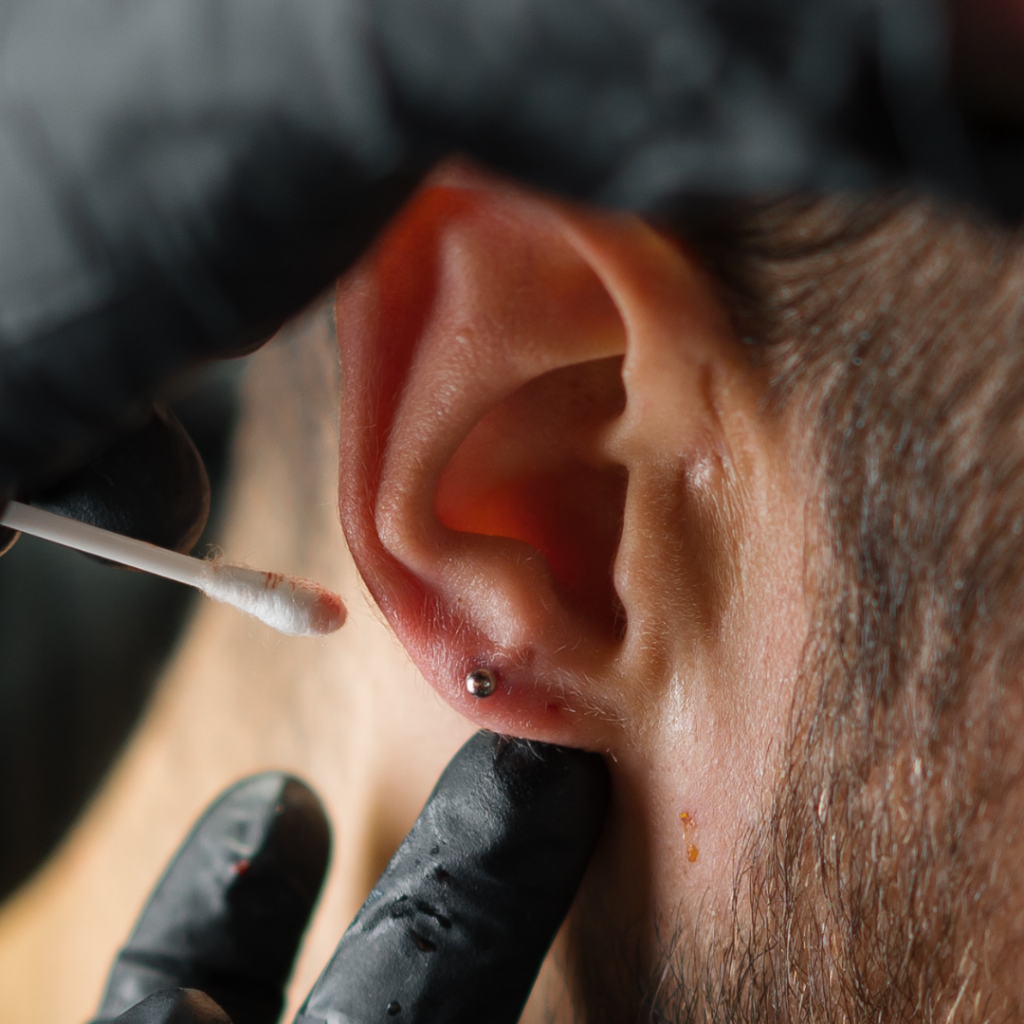Clients can sometimes slack on proper piercing aftercare—but you know just how important it is. Here’s how to cut through the noise, give your clients the info they need, and make sure they don’t ghost the healing process.
Why is Piercing Aftercare Important?
Remind your clients that their new piercing is an investment, something worth protecting so it heals well and looks great for the long haul. Aftercare is what keeps it on track.

Without the right care, things can go south pretty quickly. We’re talking:
- The piercing moving from its original spot
- Closing up partially or completely
- Infections
- Scarring (think keloid, hypertrophic, or atrophic scars)
For more detailed information on scars and scar prevention, point your clients to the Guide to Piercing Aftercare – How to Avoid Scars and Promote Healing.
Helping clients understand what’s at stake makes them way more likely to follow through with proper aftercare—and keeps their piercing (and health) in great shape.
Piercing Aftercare and Healing Time
One of the first questions your client’s probably going to ask is, “How long before it’s healed?” And the honest answer? It depends—but the better their aftercare, the smoother and quicker the healing process.

Let them know that a solid aftercare routine makes all the difference. Here’s why:
- AFTERCARE KEEPS BACTERIA AWAY: Saline washes, like Recovery Saline Wash, help rinse away bacteria, dust, and dried lymph—basically, all the stuff that can mess with the healing process and lead to infection or other complications.
- GOOD PRACTICES PREVENT FURTHER IRRITATION: clients cleaning their hands and handling their piercing gently = less risk of further irritation or introducing germs to the piercing site.
Reassure them if they’re consistent and stick to a good routine, they’ll be rocking a beautifully healed piercing before they know it.
Of course, aftercare can vary depending on where the piercing is. So, how should your client care for their piercing if it’s in a “non-traditional” area?
Piercing Healing Time by Location
Your client must understand that not all piercings heal the same way or at the same speed. Help them see that:
- Healing time and aftercare methods vary by piercing. What works for an ear piercing won’t be the same as what’s needed for a nipple piercing. The same goes for how long each one takes to heal fully.
- Piercings heal from the outside in. So, even if the outside looks good, the inside tissue could still be healing. It’s a slow process, and patience is key.
Once clients understand that healing is a gradual process influenced by location, they’re less likely to panic if healing takes a while.
So, what’s a realistic timeline for healing? Check out the guidelines below for common piercings like the ear, belly button, nose, and nipple.
Ear Piercings
You know that ears can be tricky. With all those curves and ridges, healing time depends on where the piercing is. But new clients might be worried if their piercing hasn’t healed after a month. Here’s your moment to get them back on track.

- Encourage your client to be patient. Let your client know that healing isn’t instant—lobe piercings typically take around six weeks, while cartilage can take twelve weeks or more. It’s important that they give their piercing time to heal both inside and out.
- Remind your client not to “test” their piercing by taking the jewelry out. It might look fine on the outside, but the inside is still healing.
- Reemphasize that rushing the process or skipping aftercare can slow things down. Encourage your client to stick with it—their ear will thank them.
Belly Button Piercings
You’re usually met with a frustrated client when you tell them their belly button piercing will take around three to six months (or longer) to heal. But if you explain why, clients are often more willing to be patient and follow your aftercare tips. Let them know:
- Belly buttons trap dirt and bacteria, so keeping it clean and covered will help it heal quicker.
- Snags from clothing (like waistbands or underwear) can irritate the area and reset the healing clock.
- Constant movement of the torso means the piercing is under stress, which slows things down.
Reassure them that though these things can happen, they can avoid much of it by following your aftercare guidelines. If they do, their belly button piercing will heal up beautifully.

Also, point them to The Ultimate Guide to Belly Button Piercings for in-depth information about what to expect during the healing process.
Nose Piercings
Due to their location, nose piercings are easy to show off—and easy to fiddle with. If your client is itching to change their jewelry, here’s what to remind them:
- Nose piercings still need proper time to heal. Remind them that even though nose piercings usually heal in about two to four months, it’s not okay to swap jewelry after just a few weeks.
- Warn your client of the consequences. Let them know that changing it too soon causes irritation or delays healing.
- Encourage your client to stay patient. Help them choose stylish, hypoallergenic jewelry for their first piercing so they’re less tempted to switch things up too early.

If your client is curious about aftercare, types of nose jewelry, or when it’s safe to switch it up, send them to The Ultimate Guide to Nose Rings & Nose Piercings for in-depth info on nose piercing aftercare and more.
Nipple Piercings
Let’s be honest—waiting nine to twelve months for a piercing to heal can feel like forever. But, setting expectations and offering support can make a big difference. Here’s what to let your client know:
- Aftercare is everything. Following your instructions closely can make the healing process smoother and faster.
- Environmental factors affect the healing timeline. Friction, bacteria, and other irritants slow things down. So, they should try to protect their nipple piercings.
- Everyone heals at their own pace. Some people heal faster than others—and that’s totally normal. If they stick with the aftercare for the full healing timeline, they should be good to go.

Share Nipple Piercing Healing and Aftercare to help them feel even more prepared for what to expect after they leave your shop.
Moral of the Story: Healing Takes Time
Your client needs to understand that, at the end of the day, a piercing is a wound—and that’s exactly how the body treats it. It’s going to work hard to heal, but it won’t happen overnight.
The most important thing for your client to remember? If they stick to your aftercare instructions and give their body the time it needs, their piercing will heal beautifully—no matter where it is.



Comments are closed here.